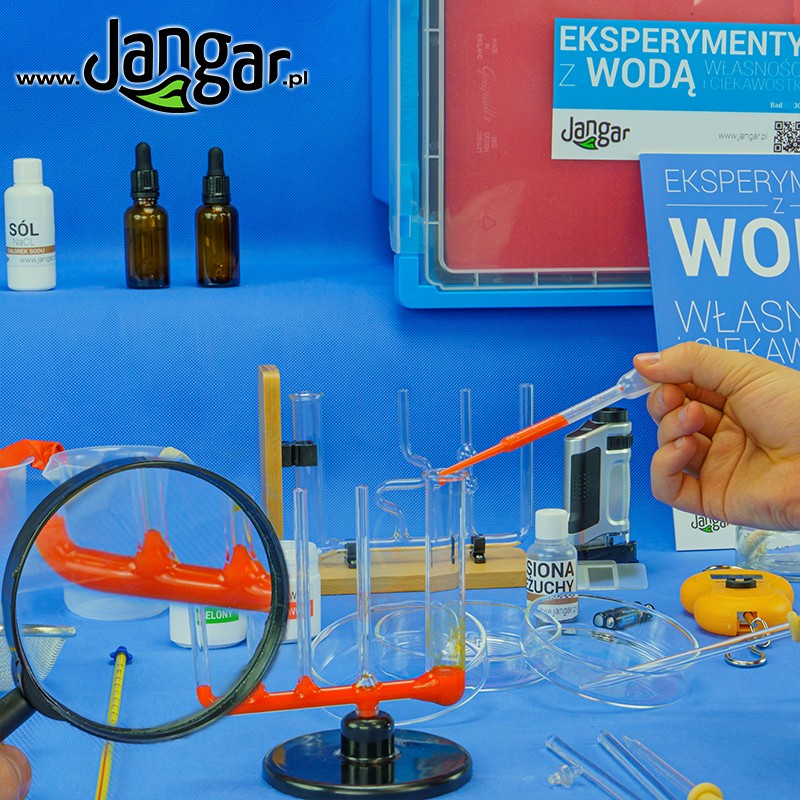Experiments with water - properties and curiosities, experimental set with laboratory equipment
Product reference: Bad000306
Tax incl.: zł595.00
Description
MACHINE TRANSLATION (not authorised yet)
The set helps to understand the incredible world of water, its secrets and properties, thanks to 35 experiments that are easy to do in a school environment, described step by step. The kit includes the laboratory equipment needed to conduct the experiments and the same equipment used in chemical laboratories - so the kit is also a good introduction to the world of scientific research.
The attached manual contains sheets of 35 carefully designed water experiments with a discussion of the results of each of them and conclusions, as well as an indication of the expressions and concepts the students learn during and after the experiment.
The task of this experimental set is to learn about the properties of water, its complex nature and interesting features that still amaze scientists and constantly affect the life of our and our planet - remember that man consists of more than 60% water and 75% of the Earth is covered by water...
These 35 experiments are supposed to make students aware of how these seemingly simple particles - H2O - show a lot of interesting features under various conditions. We meet water every day, and in the school curriculum it is present in every subject, so it is worth getting to know it better.
The whole set is delivered in a 2-level, lockable plastic container with sponge inserts, which have cut-out sockets for the set elements so that they can be easily and safely removed and stored.
Drawing:
- measuring cup borosilicate glass bead high 250 ml - 2 pieces
- Phine measuring beaker PP 250 ml - 2 pcs.
- 75 mm plastic funnel - 2 pieces
- Laboratory filtrates diameter 125 mm - 50 pcs.
- LED hand microscope with table 20x-40x
- glass slice with a 75 mm handle
- Spectacle magnifier 10x, retractable
- food colouring - green/blue
- food colouring - red
- 30ml bottle with a dropper, glass - 2 pieces
- office clip - 6 pcs.
- glass baguette - 2 pcs.
- drapper - 2 pcs.
- Pasteur pipette 3 ml - 2 pieces
- 60 ml spirit burner with wick
- Laboratory beaker tongs
- balloon - 2 pcs.
- a metal skull
- sittle
- laboratory glass thermometer -10...+110 st.C mercury-free
- Petri dish glass - 2 pcs.
- acrylic prism for filling
- vascular connected
- vascular- capillary tubes
- electronic spring weight 40 kg/10g
- straw
- brush
- sowed cress
- salt
- plastine - 2 pieces
- waterproof marker
- pH bands 4-field - 100
- plastic jar with screw cap
- sticker tape
- board- matrix WATER IN THE ENVIRONMENT, 66x46 cm
- plastic box, two-level with cover, with cut-outs for set elements
Description of EXPERIMENTS:
- Will water split the light?
- Does water break and move objects?
- Does water hide and move objects?
- Swap seats.
- Swap places, part 2, that is how to dip the paper in water and not get it wet.
- The omnipresent water that we don't always see.
- Is water molecular?
- What disappears in the water?
- What disappears in the water? Part 2
- If it dissolves in water, it dissolves in another?
- More or less?
- Why isn't the ice sinking?
- Does water always have the same volume?
- Does water always have the same volume? Part 2
- Does the water cool everywhere the same?
- Would the molten floe raise the water level in the reservoir?
- Why do we sprinkle salt on the road in winter?
- What lives in the water?
- Water is essential for animals and plants.
- Do plants like any water?
- Water density and sea currents.
- Why doesn't a drop of water spill?
- Why doesn't a drop of water spill? Part 2
- Can you "walk" on water?
- Can you "lie" on the water?
- Does a drop of water increase?
- The water pressure - always the same?
- All the water - dishes connected.
- All water - capillaries.
- All water--walking.
- What did Archimedes discover?
- Why do some bodies sink in water and others don't, though they weigh the same?
- Why do some bodies sink in the water and others don't, though they weigh the same? Part 2
- About and bend the water jet.
- Why do we test the pH of the water?












































































































































































































































































































































